I found Franz Kafka’s Metamorphosis to be a story that the reader can visualize and interpret in many different ways. As I read Metamorphosis, I thought of certain images and music that I know of. Here are several images and music that I thought of while reading:
This piece of classical music is called “Montagues and Capulets” from Prokofiev’s ballet, Romeo and Juliet. I thought of this piece of music as Gregor awakens from discovering that he had transformed into a giant vermin. The dramatic explosions of sound at the beginning represent the shock that I personally would have felt if I were him. The famous dance around 1:34 reminded me of Gregor struggling to move out of his bed. The melodies played by the brass (notably trumpets and horns) can be visualized as Gregor’s parents and the Chief Clerk pressuring him to open the door.
Although this may be a little bit exaggerated, I felt that the impact of the kick Gregor’s father executes is a turning point at the end of the first part. It is the kick that shuns Gregor into his room and marks the beginning of his eventual loss of humanity. Like the kick of this Hitmonlee (if anyone watched or played Pokemon), it is a powerful and decisive hit on Gregor as an individual.
As I continued to read about Gregor and his struggle, I find that a fear that him and I have is isolation. Behind closed doors, Gregor continued his pathetic existence as a vermin incapable of normally interacting with his family. He lived in constant shame of himself and was afraid to show himself to his loved ones. Like Gregor, I have the same fear. Being unable to express myself would be rather depressing and I would go mad from the lack of socializing. This image perfectly displays what I visualized as a read about Gregor’s isolation:
This image is a perfect example of isolation in Gregor’s case. The man in the photo looks lonely, the room he is in is unintended too, and there is a lone window that the man can look out of into the world. Gregor is alone in his room for the most part, his room eventually becomes neglected by his family, and he has a window that he tries to look out of during the early days after his metamorphosis.
This series of audio clips is what came to my mind as Grete played the violin for the three men. Kafka writes in Metamorphosis how Grete had a passion for music and how Gregor was trying to earn enough money to send her to a music conservatory. I could imagine that Grete was then a rather good violinist, so the famous violin solos of Rimsky-Korsakov’s Scheherazade came to my mind. The first solo is enchanting and like Gregor, I would be drawn to the sound of it. the beauty within its notes could tame such an animal like the one that Gregor had become.























